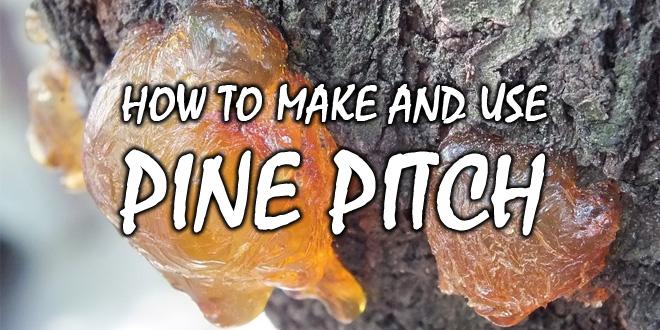Nature is really quite miraculous. Despite the fact that we live in a world full of manmade objects, mostly items that provide nothing more than convenience, we can turn to nature for substances that are often just as helpful and are also free and plentiful.
Pine pitch is one such substance, and it can be found in abundance in any coniferous forest. How useful can it be? Pine pitch actually has a number of incredible uses we will discuss in detail, but first you need to know how to get it.

Table of Contents
Harvesting Pine Pitch
Pines trees, as every other tree, contain sap, but they also contain pitch or resin (these terms will be used interchangeably throughout this article).
Whenever the tree is injured in some way, such as a gash in the bark or the loss of a branch, this pitch will flow out of the tree and cover the injured area, hardening and sealing it off against insects and other invaders.
The longer the pitch has been on the outside of the tree, the harder it will be.
If you find a tree on which the injury is relatively fresh, then you will see the whitish-colored pitch coating the area and it will still be relatively soft. It depends on how hardened it is as to how easy it will be to remove.
The best way to collect pine pitch is to find hardened resin. It will still be sticky, but easier to manage than the softer resin.
The best way to remove hard resin from the tree is to use something sharp, such as a knife or a pointed stick to pry the clump of resin off the tree.
The clearer the resin the better it is because you won’t have debris to remove from it later on. Check out this great video that shows how an ingenious way to access the resin when it’s out of reach.
If there is no resin on the outside of the tree, you can still get some, but you will have to “tap” the tree. This isn’t very complicated, but it takes a little work. Essentially, you need to injure the tree.
To do this, strip a 6-inch by 10-inch section of bark off the tree about 3 feet above the ground. Secure a bucket to the tree so the pitch can run into it (you might need to funnel the pitch into the bucket).
Next, cut gashes into the bare section of the tree so they form a V-shape with the point of the V pointing toward the bucket. The pitch will flow into the bucket, fresh and ready to use.
You can use altoids tins or some other containers to store pin resin.
Working with Pine Pitch
Before we move on to its uses, it is important to discuss working with it. If you can find pitch on the trees, this is great because it is easier to harvest than having to cut into the tree to get the pitch flowing.
However, many of the uses for pine pitch require the pitch to be in liquid form. If you want to melt down your pitch, you can certainly do this, but you need to do it carefully by taking the following steps:
- Find an appropriate fireproof container, such as a tuna can. You can also use a double boiler if you have such equipment on hand.
- Place your pitch in the can. You never want to put the pitch directly in the flames of the fire because it will ignite very easily.
- Place the can over the coals of your fire. You can place the can right on the coals, but not on the hottest coals. The idea is to have the pitch melt slowly, which will keep it from catching fire and will allow it to retain as much moisture as possible.
Pine Pitch Uses
Now that you know how to get pine pitch and melt it down, you need to know what uses it is good for. Get ready for a long list! Pine pitch can be used in the following ways.
1) Use It As Glue
You can easily make pine pitch into glue that will work to do the following:
- Repair tarps and tents
- Add fletching to arrows
- Make tools
- Make pitch (glue) sticks that you can carry with you
Here is a video on how to hot glue sticks:
2) Waterproofing
Disclosure: This post has links to 3rd party websites, so I may get a commission if you buy through those links. Survival Sullivan is a participant in the Amazon Services LLC Associates Program. As an Amazon Associate, I earn from qualifying purchases. See my full disclosure for more.
Not only does the pine pitch glue act as an adhesive; it also makes an effective sealant.
When the melted resin is mixed with charcoal and animal fats, it will create a sealant that keeps water out of anything that needs to be waterproofed or sealed, including:
- Boats
- Clothing
- Hiking boots and other footwear
- Tarps and tents
- Buckets and containers
- Roofs
- Anything else!
3) To Treat a Wound
Pine pitch is a powerful antifungal, antibacterial, antiseptic, anti-inflammatory, and astringent. You can use it to treat a wound by doing proper first aid, then applying the pitch to seal it.
To make a basic salve, do the following:
- Melt the resin slowly until it is a liquid.
- Mix the pine resin with some olive oil.
- Mix in some beeswax to make it firmer and spreadable.
Be sure to test it on a small area of the skin for an allergic reaction before applying it to a person. Some people are allergic to it.
4) To Treat a Skin Rash or Sunburn
Make the pitch into an ointment or salve to treat skins rashes, conditions like eczema and rheumatism, sprains, strains, burns, and bruises.
You can check out this article from Wild Woman Rising for instructions on how to make pine pitch oil, and pine pitch salve.
Another great recipe for a pine pitch ointment goes as follows:
- Take 2-3 tablespoons of resin and mix it with 1 tablespoon of rendered animal fat
- Add 1 teaspoon of beeswax
- Mix together and spread on affected area
As noted above, please test it on your skin for allergic reactions first.
5) As a Fire-starter
Pine pitch is very flammable, which makes it a great way to generate light and heat when you need it.
Pine pitch acts as a great fire starter, generally burning long enough to dry out tinder and kindling that is damp, and to them burning. Pine pitch will even allow you to get a fire going when it is wet and raining outside!
When it is raining or wet, all you need is a good-sized stick of wood, about 2-3 inches thick and a foot long, and a sharp knife. Split the piece of wood into small sticks of various sizes (including kindling size) and try to keep it dry.
Make some shavings as well, mix them with the resin, and light the fire with whatever method (i.e. lighter or a fire starter) you are using. If you can find fat wood or have some with you that will help.
6) To Make a Torch
Pine pitch can also be used to make a torch. You can wrap a bandana or another piece of cloth around the end of a stick and coat the fabric in pine pitch. Then light it on fire and you have a great torch to use when you need some extra light.
It is wise to remember that you cannot make an actual candle out of pine pitch – the entire thing will ignite, not just your wick. However, you can make a lamp.
Collect a rock that has a bowl-like depression and place some moss in it. Place the resin around the moss and light the moss. The moss acts as a wick and as it and the resin burn out, you can replace them.
7) Make Improvised Sandals
If you’re barefoot in the outdoors, one way to protect your feet and cover more ground is to stick sap to your feet, then walk around dead leaves for a little bit, until they stick to your soles. Then you can walk around in your new “shoes”!
8) To Remove a Sliver
You can probably imagine how it works. Simply put it soft form over the area, wait for it to harden, then pull it.
Final Words
Pine pitch is truly a wonder of nature and it is all around us. This is definitely one natural survival substance that you need to learn to find, harvest, and work with because it can literally be a life-saver (remember the ease of lighting a fire).
Plus, you will have the satisfaction of knowing that there is one less thing – actually a number of things – for which you need to rely on the consumeristic world.
With your own glue, salves and ointments, waterproofing sealant, and fire starter, you are that much more self-sufficient. So get out there and find those pine trees!


An urban prepper and rural wannabe, Karen has been working as a freelance writer for a decade and prepping for about half that time. She has gathered a wealth of knowledge on preparing for SHTF, but there is always more to learn and she has a passion for gathering and sharing that knowledge with other like-minded folk. Karen lives in London, Canada with her two children and plethora of cats.

Very good article
Thanks, Daniel! Karen did a great job.
Maybe use a milkweed pod for the resin reservoir?
That’s not pitch, that’s resin. Resin is collected from the outside of trees, and can be cooked into pitch.
Resin->Tar–>Pitch.
Tar was usually extracted from fatwood via destructive/dry distillation (ie “charring”), and further cooking of tar can produce pitch, a thicker, black product.